- Overview
- JMI Distortion Boosters
- Thomas Organ Distortion Boosters
- Jen Distortion Boosters
- Share your fuzz!
Overview
The original Vox Distortion Booster was designed in 1965, and was initially built by Jennings Musical Instruments (JMI) in the UK as part of a set of four different ‘plug-in’ Booster units: the (chrome) Treble Booster, the (black) Bass Booster, the (blue) Mic Booster, and the famous red Distortion Booster.
Unlike early foot-operated guitar effects, the series of Vox boosters were intended to be plugged directly to the amplifier’s input. They were very compact and had no controls to tweak each effect other than a (hand-operated) bypass toggle switch. As if this format wasn’t already impractical for stage use, the same switch that toggled the effect in and out on these early British models was also used to disconnect the battery. The consequence of this switching arrangement is that engaging any of these Boosters on for a guitar solo mid-song would result in a loud distracting ‘pop’ sound.
The set of four JMI Vox booster units was demonstrated at the British Musical Instrument Industries Trade Fair in August of 1965.1 Reportedly, however, there was a delay in production specific to the Distortion Booster,2 and so it’s unclear when the red model from the set actually made it to the market.



Pictured above is a selection of advertisements for the JMI Vox Distortion Boosters, along with a trio of survivors from my own collection (and I’d be delighted to hear from anyone willing to sell the Vox Mic Booster, so that I might complete the set!).
A British-built red Vox Distortion Booster can be heard on the Gremlins’ 1966 cover of ‘High Time Baby’.3 A reader recalled the Rolling Stones performing on Ready Steady Go! with a red Distortion Booster visibly plugged into one of the amps, but unfortunately the television footage is not known to have survived. The most famous user of the Vox Distortion Booster is Brian May, who had the electronics rehoused into his famous Red Special guitar. Brian May’s use of the Vox Distortion Booster can likely be heard on the early 1984 and Smile recordings. His specific unit is detailed further below.
Vox maintained production of this sort of ‘alternative form’ guitar effects units throughout the 1960s. As time went on, production of the Distortion Booster (as well as the Treble and Bass models) expanded beyond the UK. The Vox brand name appears on an assortment of very similar ‘plug-in’ style booster effects that were also built in the United States as well as in Italy, and all the different versions are explored on this page.
Jennings Musical Instruments — Vox
1965-1966 | Germanium Vox Distortion Booster
The earliest Vox Distortion Boosters were built with a germanium transistor circuit (using STC ASY50 transistors) based off Gibson’s famous Maestro Fuzz-Tone. The main differences between the two models are that the germanium Distortion Boosters omitted the first transistor stage of the Fuzz-Tone’s circuit, and that the Distortion Boosters were also powered by a 9 volt battery instead of the Fuzz-Tone’s pair of 1.5 volt batteries.
Layout #1
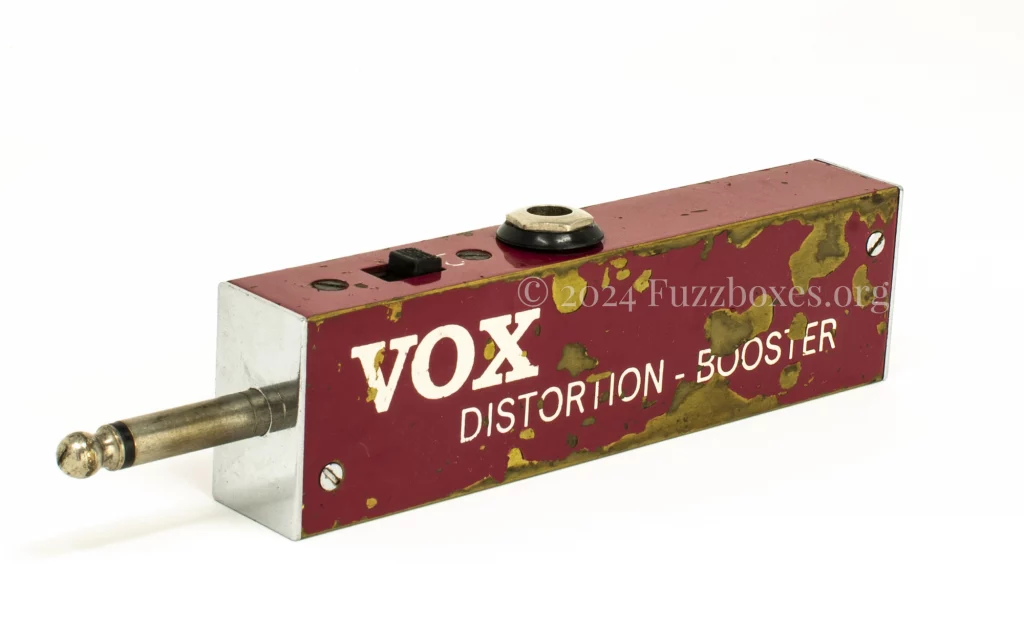
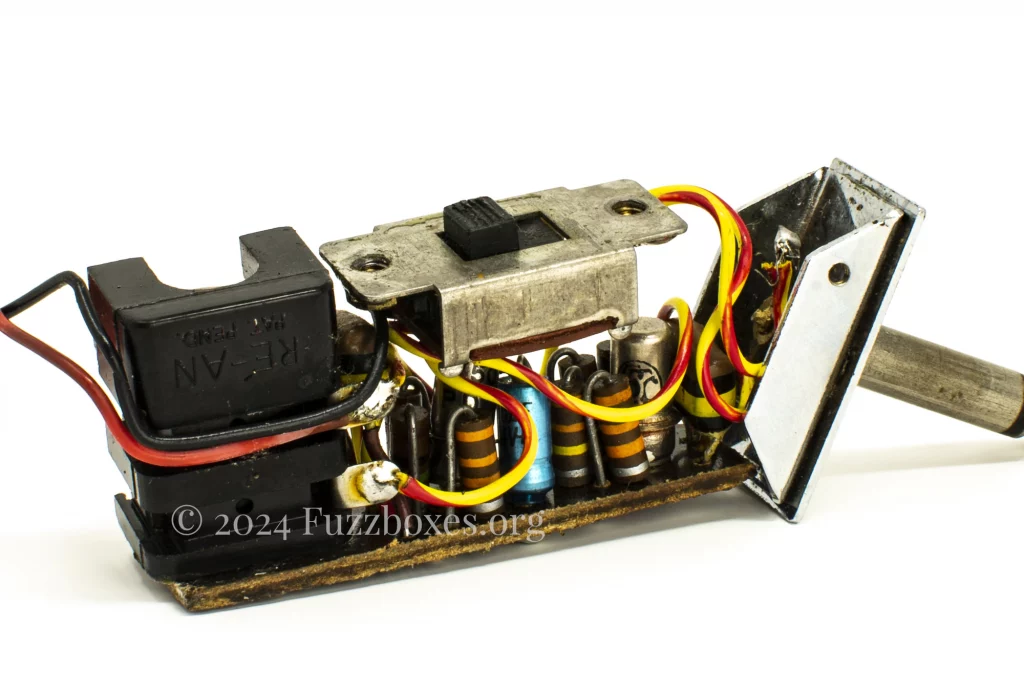
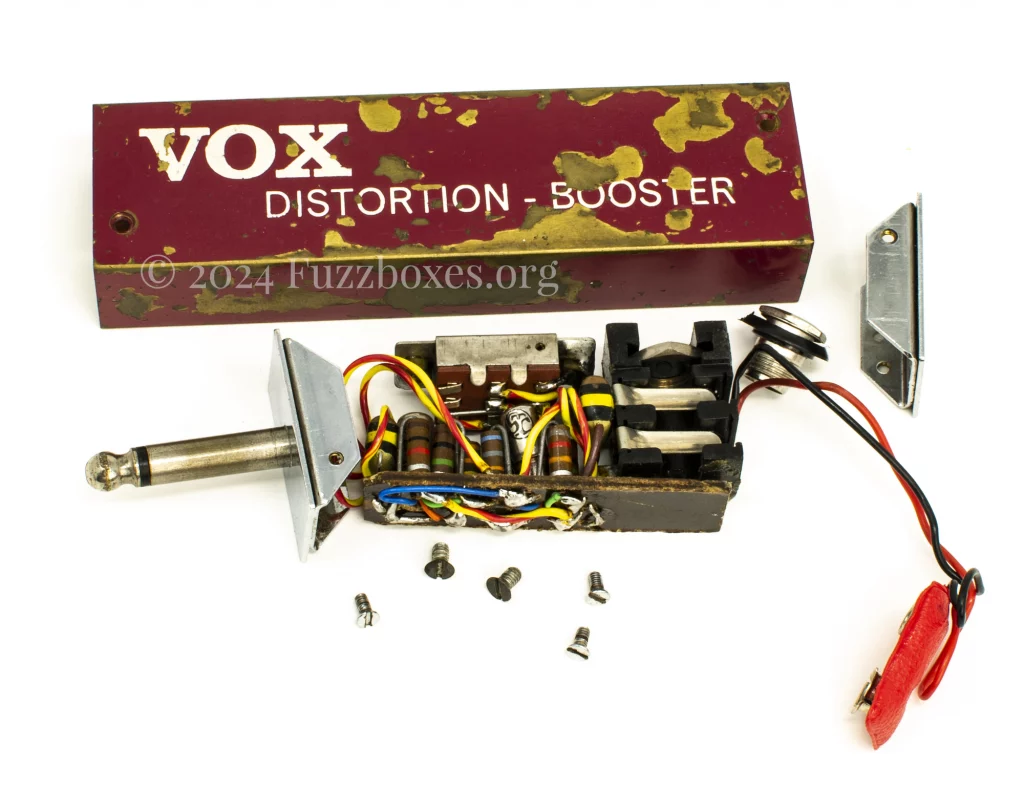
The germanium version of the Distortion Booster was probably quite short-lived due to its rarity, but nevertheless, examples have been sighted with two different parts layouts. The rusty unit pictured here features 1/2w carbon composite resistors that are mounted upright. This particular rusty unit originally belonged to Richard McCracken (who played alongside Rory Gallagher in Taste).4
Pictured below are the surviving remains of the actual Distortion Booster that was once housed in Brian May’s Red Special guitar. The parts selection and layout reveals it to be an early germanium Distortion Booster, as opposed to the later silicon transistor circuit that is often misattributed to May’s early fuzz sounds. (Photo credit: Kevin Nixon/Future Publishing)
Layout #2
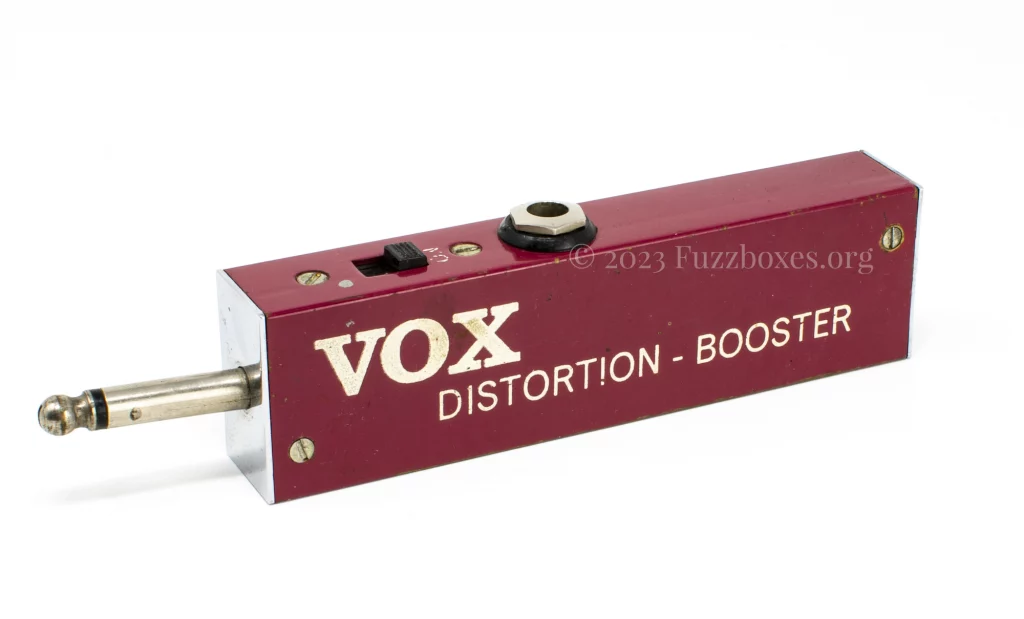

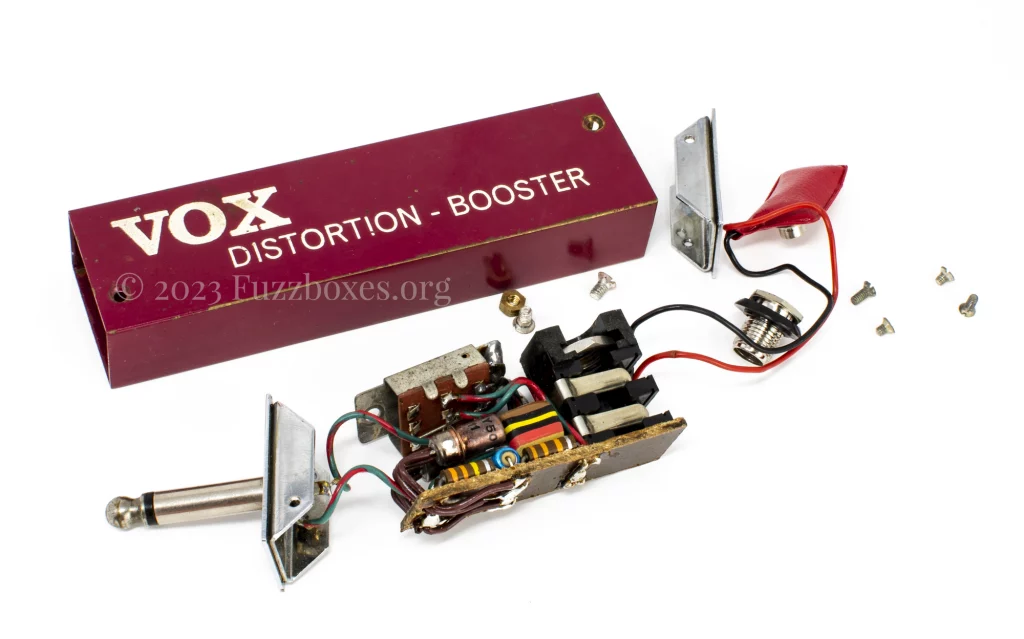
This Distortion Booster has been very well preserved over the decades, and internally, it features a visually pleasing symmetrical parts layout. The mixture of parts types and values in this booster is very similar to the rustier one pictured previously. However, these pedals are sometimes also sighted with 1/3w Iskra resistors instead of the brown 1/2w carbon composites, and it is therefore possible that these ‘symmetrical layout’ Distortion Boosters came first in the chronology. At present there is far too little information from which to draw firm conclusions. Interestingly, the germanium Distortion Boosters with this symmetrical parts layout have thus far only resurfaced in Germany and the Netherlands.
1966-1968 | Silicon Vox Distortion Booster
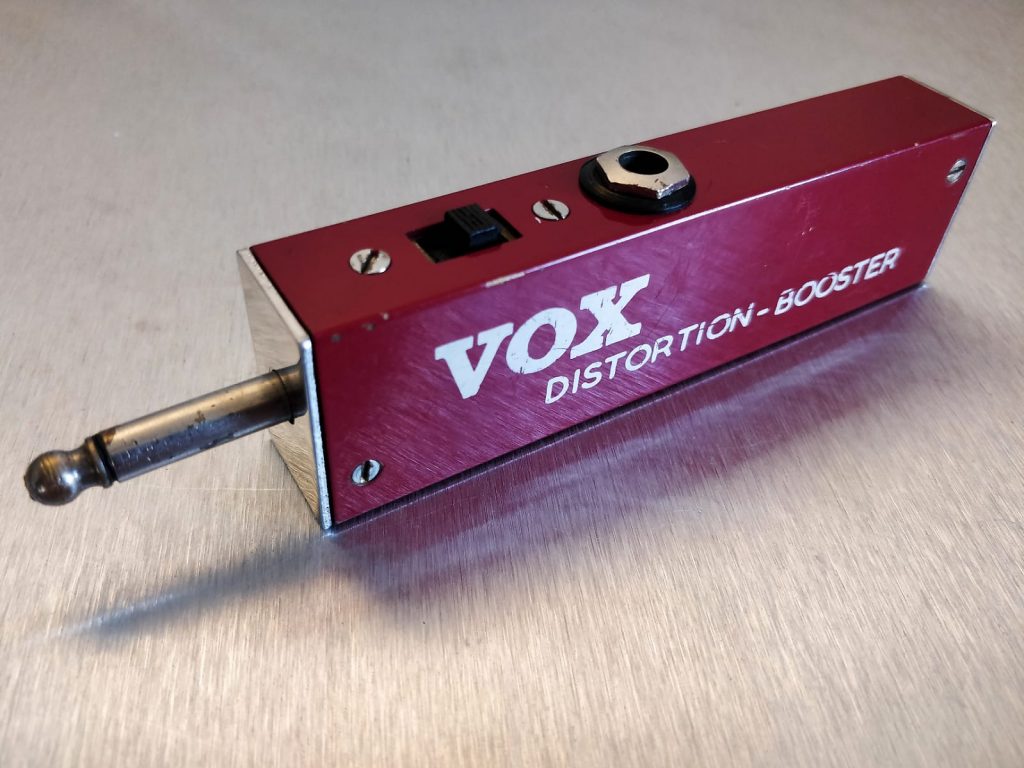


Later examples of the red model featured a BC108 silicon transistor ‘textbook’ negative feedback amplifier circuit (similar to, but not directly related with, the two-transistor Tone Benders and Fuzz Faces.) The Vox graphics on the enclosures of these silicon Distortion Boosters (and on the contemporaneous Treble and Bass Boosters) were updated at this point in the chronology, and differentiating between the two logos is a very reliable way of identifying whether a red Distortion Booster has the silicon or the germanium transistor circuit. (Photo credit: Blunt Force Audio)
As with the earlier germanium Distortion Boosters, these red silicon transistor units also often resurface in the Netherlands, which is a strong indicator that JMI had a distribution arrangement in place over there. This particular version of the Distortion Booster (as well as the JMI Vox Treble Boosters) occasionally also resurfaces in the United States, and so it’s possible that Thomas Organ initially imported the boosters before finalising the development of their own version.
Thomas Organ — Vox
1966 | Vox Distortion Booster (v816)

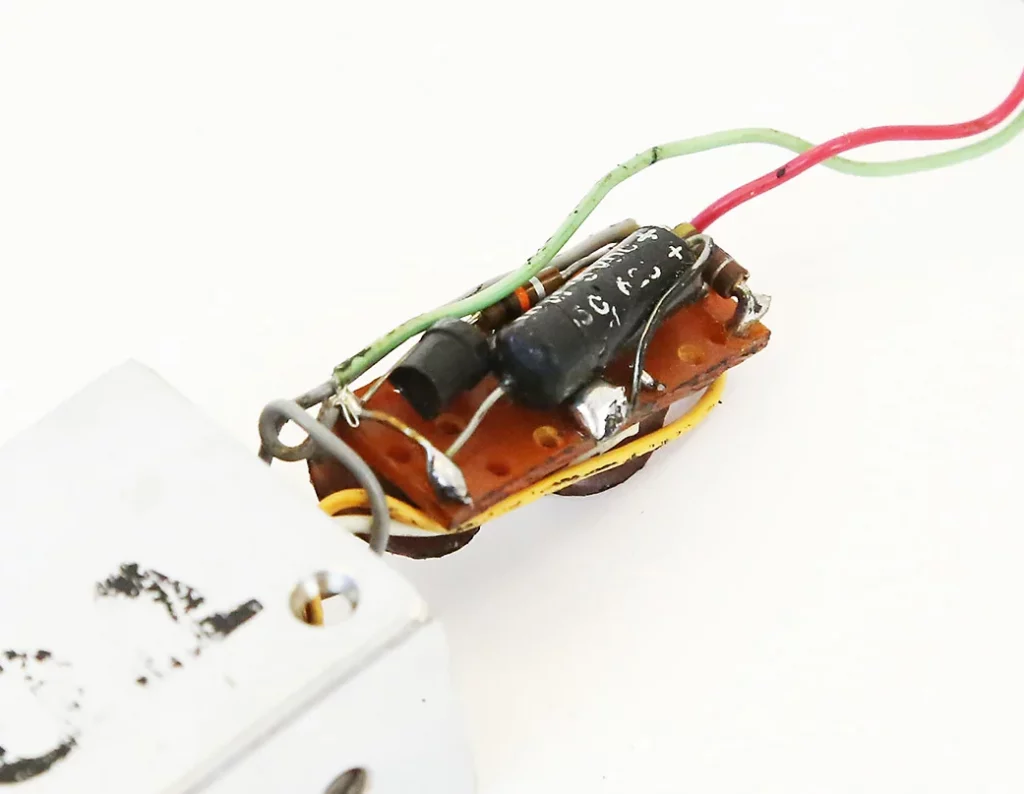
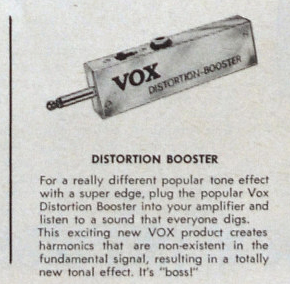
By late 1965, Thomas Organ had already begun prototyping their own version of the Distortion Booster, for distribution under Vox in the United States.5 The finished product was given the model designation ‘v816’, and it came housed in a very similar rectangular shaped casing to the JMI units (and as were the similar American-built Treble and Bass Boosters). Instead of the range of colourful paint jobs, however, the Thomas Organ Vox booster units all came in chrome. The known surviving Thomas Organ Vox Distortion Boosters all feature the silicon transistor circuit, assembled on a small piece of perfboard. This American-built v816 was more or less the same as the silicon transistor JMI Distortion Booster. (Photo credit: C. Nelson)
Thomas Organ’s Vox Distortion Booster was pictured in American Vox literature, and named on the Thomas Organ July 1966 price list. By November 1966, however, it had already been replaced with a new ‘Deluxe’ model.
1966-1968 | Vox Deluxe Distortion Booster (v8161)

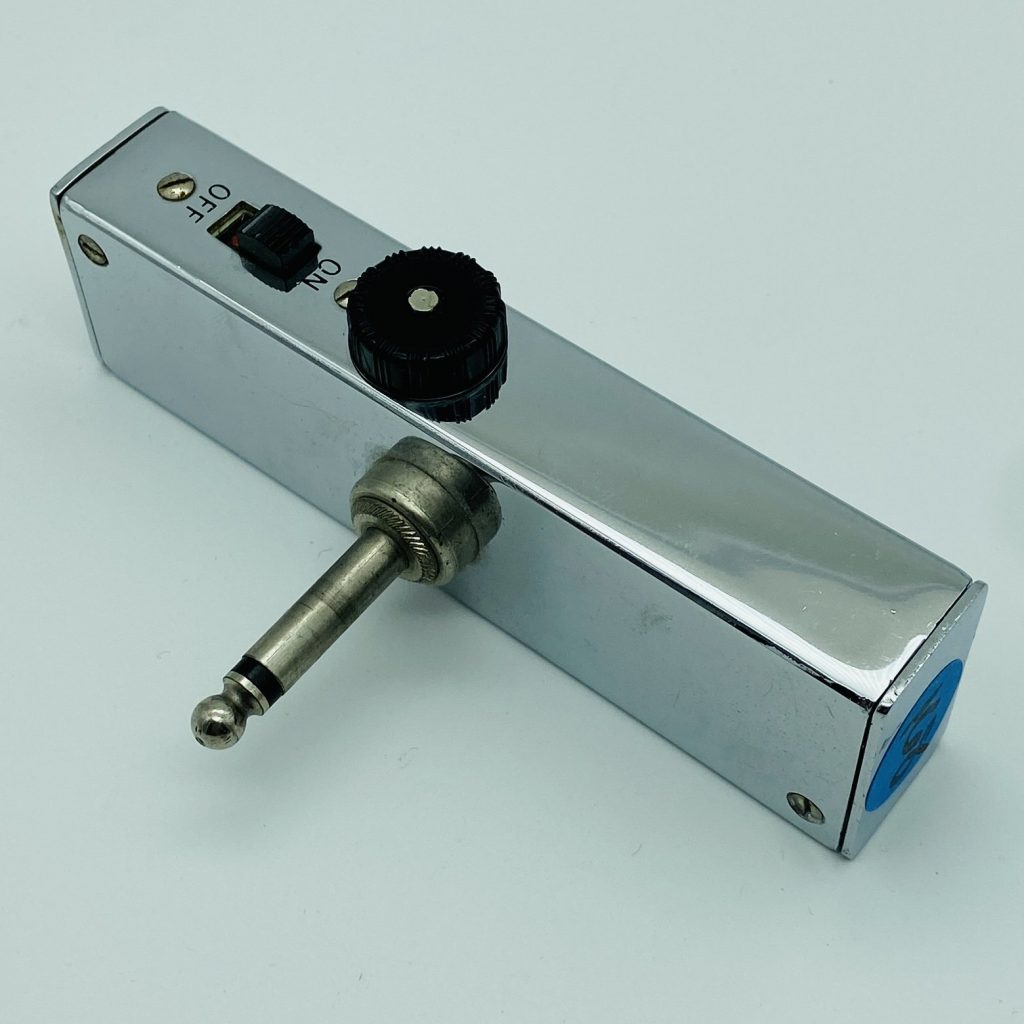
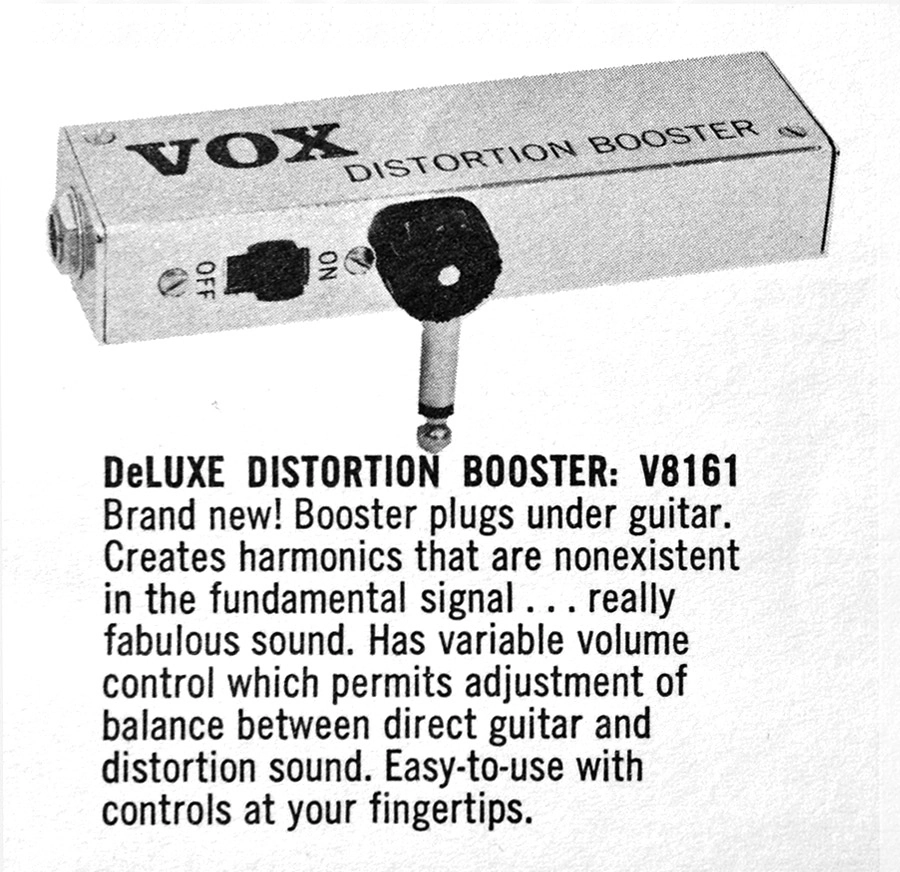
The shortcomings that plagued Vox Distortion Boosters on both sides of the Atlantic were finally addressed when a new ‘Deluxe’ Distortion Booster was announced in the November 1966 Thomas Organ accessories catalogue. The Deluxe Distortion Booster finally had an adjustable volume control fitted to it, and even more importantly, the unit was reconfigured to be plugged directly into the guitar, rather than into the amplifier’s input. This enabled players to toggle the distortion on and off while performing (provided that their guitar didn’t have a recessed jack socket). (Photo credit: Guitarworksltd)
Jen Distortion Boosters
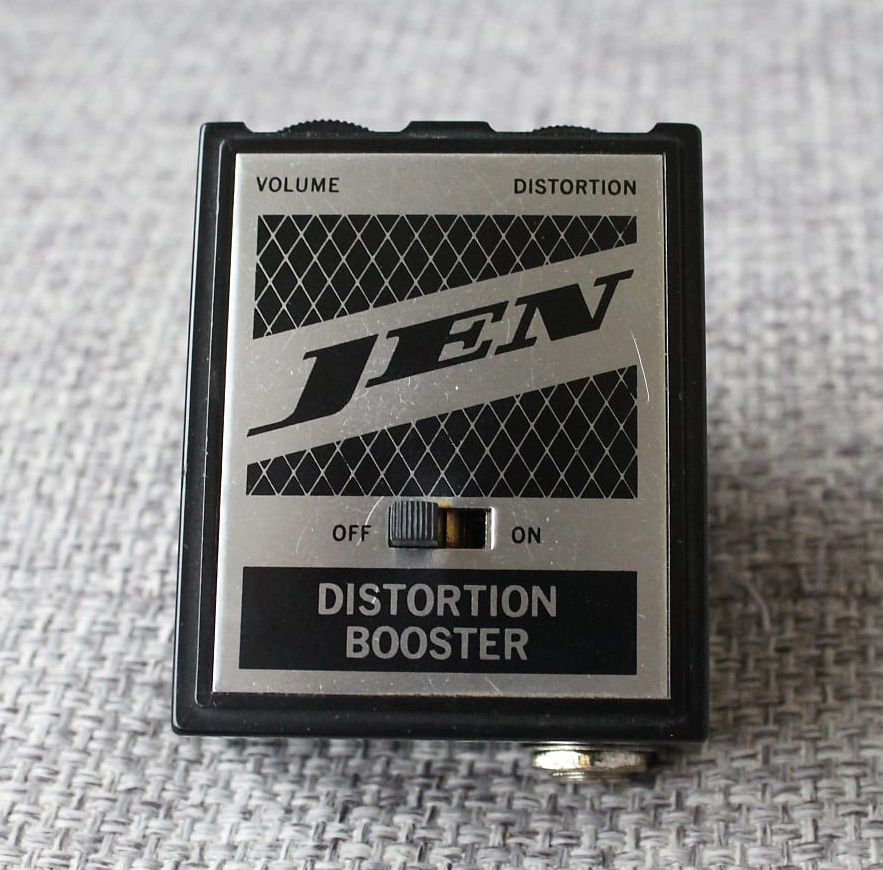
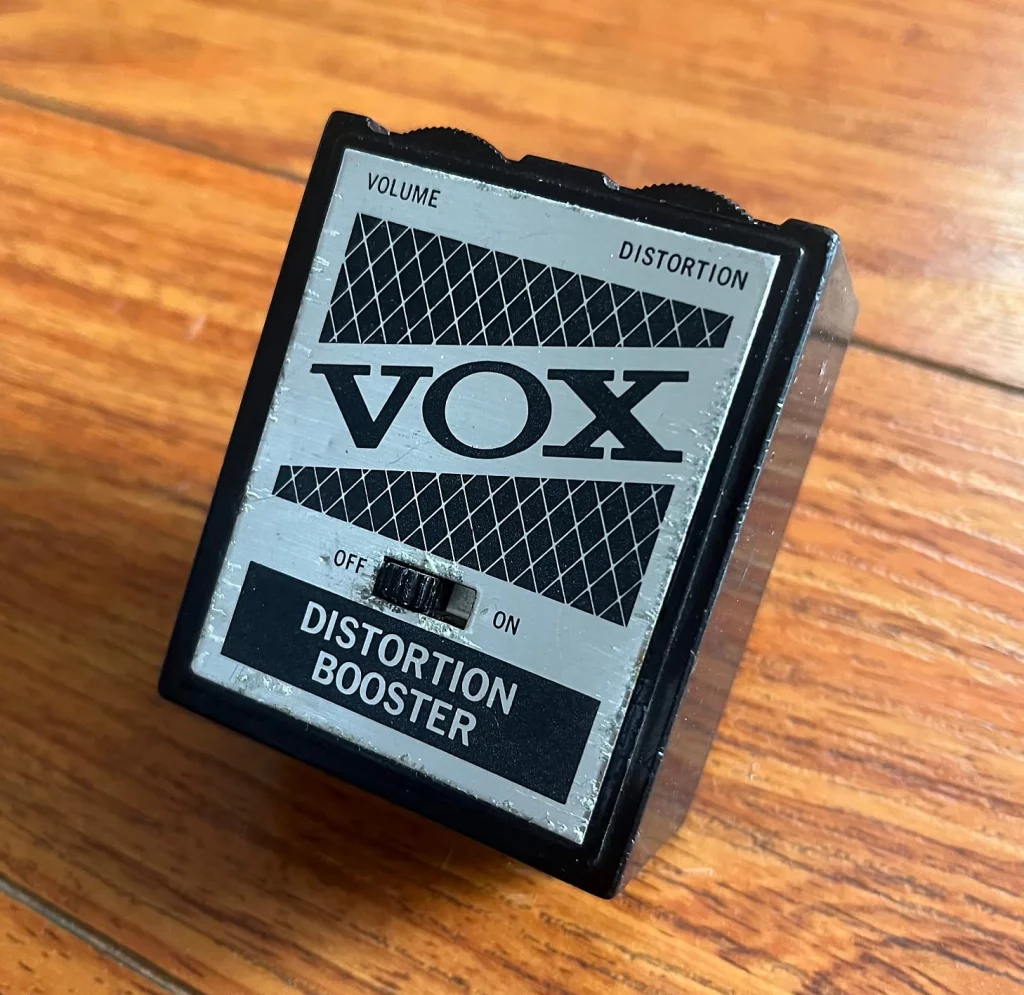

Meanwhile, back in the UK, the red-coloured (JMI) Vox Distortion Boosters were likely discontinued around the time of JMI’s dissolution in 1968. In the same year, the British music retailer, Rosetti, began running advertisements in the press for a series of Italian-built Jen effects pedals.6 Among them was a new version of the plug-in Distortion Booster. (Photo credit: Reverb.com)
The new model featured a silicon transistor fuzz circuit, housed in a square plastic casing, and most notably, was designed to be fitted directly to the guitar’s output rather than to the amplifier. This was also the first time that a Distortion Booster unit was built with a potentiometer to adjust the intensity of the fuzz sound.
Thomas Organ also ceased production of the rectangular chrome Deluxe Distortion Boosters in 1968, when a new Vox-branded model, identical to the Jen unit, began appearing in American Vox catalogues. Jen was already responsible for supplying Vox-branded Tone Benders & wah-wah pedals to the American market, and these Italian-built Distortion Boosters were both functionally and electronically also similar to the British counterpart.
For the remainder of the 1960s and well into the 1970s, Distortion Boosters were manufactured at the same facility in Italy for both the British, American and European markets.
Share your fuzz!
I welcome any comments, feedback, queries & corrections in relation to the Fuzzboxes.org project. Please get in touch via this contact form (or on the ‘contact‘ page).
Much of our understanding of the development of 1960s fuzz boxes comes from analysis of surviving pedals themselves, and so photos of pedals belonging to readers are particularly useful in furthering this research.
If you would like to contribute pictures of 1960s-era guitar effects to Fuzzboxes.org, then feel free to send in any pictures via the uploader below. Photos are greatly appreciated, and any submissions are not published on this website without advance agreement with the contributor.
Thanks to J. Voggenthaler/Electric Warrior & the Vox AC100 website (https://www.voxac100.org.uk)


I’m looking for a schematic for a version of the Vox Deluxe Distortion which looks like the Jen model you show on your Fuzzboxes page. Like in the picture, there are two pots, Volume & Distortion. The schematic I have of the V8162 Model released May 1969 is not the same as my old 1968 unit. Is there a 1968 model between V8161 & 62? I still have the circuit board from my old unit but it’s been mostly cannibalized. I’d like to re-populate the board but I need more information as the circuit is noticeably different. Any thoughts, anyone?
Interesting! I wasn’t aware that there was a different version of the circuit in those Italian-made square boxes (but to be completely honest, I haven’t actually seen inside very many of them either). If you’d like to send me some photos of the remains of your Distortion Booster (via the ‘contact’ page at the top of this site), then I’ll happily compare it with what little data about the model I have.